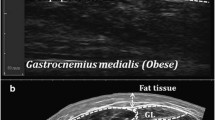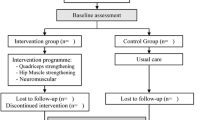Abstract
The purpose of this study was to investigate if obese children have reduced knee extensor (KE) strength and to explore the relationship between adiposity and KE strength. An observational case–control study was conducted in three Australian states, recruiting obese [N = 107 (51 female, 56 male)] and healthy-weight [N = 132 (56 female, 76 male)] 10- to 13-year-old children. Body mass index, body composition (dual energy X-ray absorptiometry), isokinetic/isometric peak KE torques (dynamometry) and physical activity (accelerometry) were assessed. Results revealed that compared with their healthy-weight peers, obese children had higher absolute KE torques (P ≤ 0.005), equivocal KE torques when allometrically normalized for fat-free mass (FFM) (P ≥ 0.448) but lower relative KE torques when allometrically normalized for body mass (P ≤ 0.008). Adjustments for maternal education, income and accelerometry had little impact on group differences, except for isometric KE torques relative to body mass which were no longer significantly lower in obese children (P ≥ 0.013, not significant after controlling for multiple comparisons). Percent body fat was inversely related to KE torques relative to body mass (r = −0.22 to −0.35, P ≤ 0.002), irrespective of maternal education, income or accelerometry. In conclusion, while obese children have higher absolute KE strength and FFM, they have less functional KE strength (relative to mass) available for weight-bearing activities than healthy-weight children. The finding that FFM-normalized KE torques did not differ suggests that the intrinsic contractile properties of the KE muscles are unaffected by obesity. Future research is needed to see if deficits in KE strength relative to mass translate into functional limitations in weight-bearing activities.
Similar content being viewed by others
Abbreviations
- BMI:
-
Body mass index
- DXA:
-
Dual energy X-ray absorptiometry
- FFM:
-
Fat-free mass
- IOTF:
-
International Obesity Task Force
- ICC:
-
Intra class correlation coefficient
- KE:
-
Knee extensor
- SES:
-
Socioeconomic status
References
Almuzaini KS (2007) Muscle function in Saudi children and adolescents: relationship to anthropometric characteristics during growth. Pediatr Exerc Sci 19(3):319–333
Baranowski T (1988) Validity and reliability of self-report measures of physical activity: an information processing perspective. Res Q Exerc Sport 59(4):314–327
Blimkie CJ, Ebbesen B, MacDougall D, Bar-Or O, Sale D (1989) Voluntary and electrically evoked strength characteristics of obese and nonobese preadolescent boys. Hum Biol 61(4):515–532
Blimkie CJ, Sale DG, Bar-Or O (1990) Voluntary strength, evoked twitch contractile properties and motor unit activation of knee extensors in obese and non-obese adolescent males. Eur J Appl Physiol Occup Physiol 61(3–4):313–318
Brooks-Gunn J, Warren MP, Rosso J, Gargiulo J (1987) Validity of self-report measures of girls’ pubertal status. Child Dev 58(3):829–841
Cole TJ, Bellizzi MC, Flegal KM, Dietz WH (2000) Establishing a standard definition for child overweight and obesity worldwide: international survey. BMJ 320:1240–1243
Cole TJ, Flegal KM, Nicholls D, Jackson AA (2007) Body mass index cut offs to define thinness in children and adolescents: international survey. BMJ 335(7612):194
Drouin JM, Valovich-mcLeod TC, Shultz SJ, Gansneder BM, Perrin DH (2004) Reliability and validity of the Biodex system 3 pro isokinetic dynamometer velocity, torque and position measurements. Eur J Appl Physiol 91(1):22–29
Duche P, Ducher G, Lazzer S, Dore E, Tailhardat M, Bedu M (2002) Peak power in obese and nonobese adolescents: effects of gender and braking force. Med Sci Sports Exerc 34(12):2072–2078
Ebbeling CB, Pawlak DB, Ludwig DS (2002) Childhood obesity: public-health crisis, common sense cure. Lancet 360(9331):473–482
Gordon-Larsen P, McMurray RG, Popkin BM (2000) Determinants of adolescent physical activity and inactivity patterns. Pediatrics 105(6):e83
Janz KF (1994) Validation of the CSA accelerometer for assessing children’s physical activity. Med Sci Sports Exerc 26(3):369–375
Jaric S (2002) Muscle strength testing: use of normalisation for body size. Sports Med 32(10):615–631
Little RJ (1988) A test of missing completely at random for multivariate data with missing values. J Am Stat Assoc 83(404):1198–1202
Maffiuletti NA, Jubeau M, Agosti F, De Col A, Sartorio A (2008) Quadriceps muscle function characteristics in severely obese and nonobese adolescents. Eur J Appl Physiol 103(4):481–484
Mikesky AE, Meyer A, Thompson KL (2000) Relationship between quadriceps strength and rate of loading during gait in women. J Orthop Res 18(2):171–175
Nevill AM, Holder RL (1995) Scaling, normalizing, and per ratio standards: an allometric modeling approach. J Appl Physiol 79(3):1027–1031
Norton K, Olds T (1996) Anthropometrica: a textbook of body measurement for sports and health courses. UNSW Press, Sydney
Okely AD, Booth ML, Patterson JW (2001) Relationship of physical activity to fundamental movement skills among adolescents. Med Sci Sports Exerc 33(11):1899–1904
Okely AD, Booth ML, Chey T (2004) Relationships between body composition and fundamental movement skills among children and adolescents. Res Q Exerc Sport 75(3):238–247
Puyau MR, Adolph AL, Vohra FA, Butte NF (2002) Validation and calibration of physical activity monitors in children. Obes Res 10(3):150–157. doi:10.1038/oby.2002.24
Rice WR (1989) Analyzing tables of statistical tests. Evolution 43(1):223–225
Rolland Y, Lauwers-Cances V, Cristini C, Grandjean H, Banks WA, Morley JE, Vellas B (2007) Disability in obese elderly women: lower limb strength and recreational physical activity. Obes Res Clin Pract 1(1):39–51
Slemenda C, Brandt KD, Heilman DK, Mazzuca S, Braunstein EM, Katz BP, Wolinsky FD (1997) Quadriceps weakness and osteoarthritis of the knee. Ann Intern Med 127(2):97–104
Slemenda C, Heilman DK, Brandt KD, Katz BP, Mazzuca SA, Braunstein EM, Byrd D (1998) Reduced quadriceps strength relative to body weight—a risk factor for knee osteoarthritis in women? Arthritis Rheum 41(11):1951–1959
Tanner JM (1962) Growth at adolescence, 2nd edn. Blackwell Scientific, London
Trost SG, Ward DS, Moorehead SM, Watson PD, Riner W, Burke JR (1998) Validity of the computer science and applications (CSA) activity monitor in children. Med Sci Sports Exerc 30(4):629–633
Tsiros MD, Coates AM, Howe PR, Grimshaw PN, Buckley JD (2011a) Obesity: the new childhood disability? Obes Rev 12(1):26–36
Tsiros MD, Grimshaw PN, Shield AJ, Buckley JD (2011b) The Biodex isokinetic dynamometer for knee strength assessment in children: advantages and limitations. Work 39(2):161–167
Tsiros MD, Grimshaw PN, Shield AJ, Buckley JD (2011c) Test–retest reliability of the Biodex system 4 isokinetic dynamometer for knee strength assessment in paediatric populations. J Allied Health 40(3):115–119
Tsiros MD, Buckley JD, Howe PRC, Olds T, Walkley J, Taylor L, Mallows R, Hills AP, Kagawa M, Coates AM (2012) Day-to-day physical functioning and disability in obese 10–13 year olds. Pediatr Obes [Epub ahead of print]
Wiggin M, Wilkinson K, Habetz S, Chorley J, Watson M (2006) Percentile values of isokinetic peak torque in children six through thirteen years old. Pediatr Phys Ther 18(1):3–18
Wren TA, Engsberg JR (2007) Normalizing lower-extremity strength data for children without disability using allometric scaling. Arch Phys Med Rehabil 88(11):1446–1451
Acknowledgments
Thanks to Professor Adrian Esterman for advice on statistical analysis and to Professor Timothy Olds for general advice when designing this study. We thank Ms. Keren Kneebone, Dr. Rachel Wood, Mr. Kaine Grigg, Ms. Fiona Spargo and Ms. Kate Greenway for technical assistance. Thanks to Mrs. Josephine Varney for advice regarding allometric modeling. This study was funded by a seeding grant from the Physiotherapy Research Foundation and internal funds (ATN Centre for Metabolic Fitness). Margarita Tsiros was supported by an Australian Post Graduate Award and the Nutritional Physiology Research Centre.
Conflict of interest
The authors declare they have no conflict of interest.
Author information
Authors and Affiliations
Corresponding author
Additional information
Communicated by Alain Martin.
This research was conducted in Australia in accordance with Australian law.
Rights and permissions
About this article
Cite this article
Tsiros, M.D., Coates, A.M., Howe, P.R.C. et al. Knee extensor strength differences in obese and healthy-weight 10-to 13-year-olds. Eur J Appl Physiol 113, 1415–1422 (2013). https://doi.org/10.1007/s00421-012-2561-z
Received:
Accepted:
Published:
Issue Date:
DOI: https://doi.org/10.1007/s00421-012-2561-z




